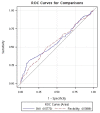Reduced flexibility associated with metabolic syndrome in community-dwelling elders
- PMID: 25614984
- PMCID: PMC4304714
- DOI: 10.1371/journal.pone.0117167
Reduced flexibility associated with metabolic syndrome in community-dwelling elders
Abstract
Background: The ageing process may lead to reductions in physical fitness, a known risk factor in the development of metabolic syndrome. The purpose of the current study was to evaluate cross-sectional and combined associations of metabolic syndrome with body composition and physical fitness in a community based geriatric population.
Methods: A total of 628 community-dwelling elders attending a geriatric health examination were enrolled in the study. The diagnosis of metabolic syndrome was based on the modified National Cholesterol Education Program Adult Treatment Panel III (NCEP ATP III) criterion with Asian cutoff of waist girth was adopted in this study. Body composition was obtained using bioimpedance analysis, and physical fitness was evaluated through the measurement of muscle strength (handgrip force), lower extremity muscle endurance (sit-to-stand test), flexibility (sit-and-reach test), and cardiorespiratory endurance (2-minute step test). Multivariable logistic regression and correlation analysis were performed to determine the association of metabolic syndrome with body composition and functionality variables.
Results: Metabolic syndrome was associated with increased skeletal muscle index (SMI) (odds ratio (OR), 1.61, 95% confidence interval (CI), 1.25-2.07) and decreased flexibility (OR, 0.97, 95% CI, 0.95-0.99) compared with those without metabolic syndrome. When body mass index was accounted for in the analysis, the association of SMI with metabolic syndrome was reduced. Waist circumference was positively correlated with SMI but negatively correlated with flexibility, whereas high density lipoprotein was positively correlated with flexibility but negatively correlated with SMI.
Conclusion: Reduced flexibility was positively associated with metabolic syndrome independent of age, gender, body composition, and functionality measurements in a community based geriatric population. Significant associations between metabolic syndrome with muscle strength and cardiorespiratory fitness in the elderly were not observed. Furthermore, flexibility should be included in the complete evaluation for metabolic syndrome.
Conflict of interest statement
Figures
Similar articles
-
Cardiorespiratory fitness is strongly linked to metabolic syndrome among physical fitness components: a retrospective cross-sectional study.J Physiol Anthropol. 2020 Oct 1;39(1):30. doi: 10.1186/s40101-020-00241-x. J Physiol Anthropol. 2020. PMID: 33004082 Free PMC article.
-
Lack of association of body composition and functionality variables with metabolic syndrome in the elderly.Metab Syndr Relat Disord. 2014 Sep;12(7):397-401. doi: 10.1089/met.2014.0012. Epub 2014 Jul 14. Metab Syndr Relat Disord. 2014. PMID: 25019528
-
Association of School Environment and After-School Physical Activity with Health-Related Physical Fitness among Junior High School Students in Taiwan.Int J Environ Res Public Health. 2017 Jan 15;14(1):83. doi: 10.3390/ijerph14010083. Int J Environ Res Public Health. 2017. PMID: 28098836 Free PMC article.
-
Decreased functional capacity and muscle strength in elderly women with metabolic syndrome.Clin Interv Aging. 2013;8:1377-86. doi: 10.2147/CIA.S50333. Epub 2013 Oct 9. Clin Interv Aging. 2013. PMID: 24143083 Free PMC article.
-
Association of Muscular Fitness and Body Fatness with Cardiometabolic Risk Factors: The FUPRECOL Study.Nutrients. 2018 Nov 12;10(11):1742. doi: 10.3390/nu10111742. Nutrients. 2018. PMID: 30424569 Free PMC article.
Cited by
-
Serum reference value of two potential doping candidates-myostatin and insulin-like growth factor-I in the healthy young male.J Int Soc Sports Nutr. 2017 Jan 5;14:2. doi: 10.1186/s12970-016-0160-9. eCollection 2017. J Int Soc Sports Nutr. 2017. PMID: 28077934 Free PMC article.
-
Association of Physical Fitness Performance Tests and Anthropometric Indices in Taiwanese Adults.Front Physiol. 2020 Nov 20;11:583692. doi: 10.3389/fphys.2020.583692. eCollection 2020. Front Physiol. 2020. PMID: 33329032 Free PMC article.
-
Association between physical activity and the prevalence of metabolic syndrome: from the Korean National Health and Nutrition Examination Survey, 1999-2012.Springerplus. 2016 Oct 25;5(1):1870. doi: 10.1186/s40064-016-3514-5. eCollection 2016. Springerplus. 2016. PMID: 27822444 Free PMC article.
-
Association between handgrip strength and metabolic syndrome: A meta-analysis and systematic review.Front Nutr. 2022 Dec 1;9:996645. doi: 10.3389/fnut.2022.996645. eCollection 2022. Front Nutr. 2022. PMID: 36532558 Free PMC article.
-
Suboptimal Tongue Pressure Is Associated with Risk of Malnutrition in Community-Dwelling Older Individuals.Nutrients. 2021 May 27;13(6):1821. doi: 10.3390/nu13061821. Nutrients. 2021. PMID: 34071812 Free PMC article.
References
Publication types
MeSH terms
LinkOut - more resources
Full Text Sources
Other Literature Sources
Medical


